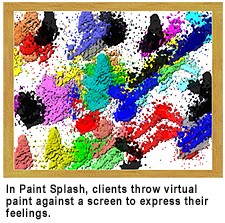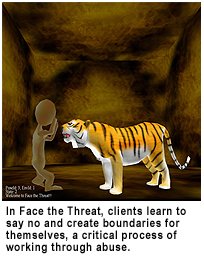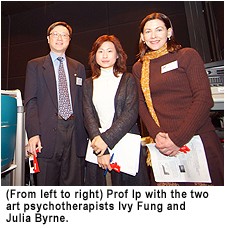Virtual reality meets art therapy in pioneering psychotherapy project
Researchers at City University of Hong Kong (CityU) and their collaborating
partners from the Hong Kong Association of Art Therapists (HKAAT) have unveiled Smart Ambience Therapy (SAT).
SAT is a pioneering application of interactive media and virtual reality technology in art therapy, particularly for the psychotherapy of children who have been physically or emotionally abused. It has been developed by a team of art therapists and experts in interactive multimedia technology at the AIMtech Centre, one of the Applied Strategic Development Centres at CityU.
The SAT project demonstrates fully CityU's commitment to applied research and helping to improve the lives of people in the community.
According to Professor (Chair) Horace Ip, Department of Computer Science and Director of AIMtech, the SAT project goals are 1) to provide a new medium that helps clients address negative feelings and low self-esteem resulting from abuse; 2) to provide an environment for communication and a creative emotional outlet for clients; and 3) to create a unique process of accessing one's internal world through kinaesthetic movement.
SAT activities such as "Paint Splash" invite the client to throw paint (conceptually) against a screen, giving the therapists an understanding of the client's feelings. In "Face the Threat," clients are encouraged to overcome fear and anger by controlling 3-D images of animals that pose a "threat" and thereby create boundaries, a critical process of working through the experience of their abuse.
"This innovative technology uses 3-D virtual reality to extend traditional games and activities used in established art therapy to create a feasible programme that can help children who have been physically and emotionally abused," Professor Ip said.
Ms Julia Byrne and Ms Ivy Fung, both practicing art therapists in the
HKAAT as well as members of the SAT team, agreed. They have witnessed a number of positive results during the recent pilot project.
"There's a lot of potential for developing this programme for therapeutic purposes, personal development and educational purposes," Ms Byrne said.
The pilot SAT project has been used with a group of children who suffer different forms of abuse. They were referred to the SAT team by youth and welfare organizations in
"To further develop and demonstrate the potential of SAT which could potentially benefit a wider variety of client groups, we welcome collaborations with professional therapists and rehabilitation centers to evaluate SAT as an innovative and effective tool for art psychotherapy," Professor Ip said.
The technology used in SAT is based on that used in the "Body Brush" and "Body Baton" projects which Professor Ip developed with research artist Mr Hay Young and research student Mr Alex Tang. These two systems use advanced visual and audio rendering techniques to express body motion into 3-D paintings and music.


